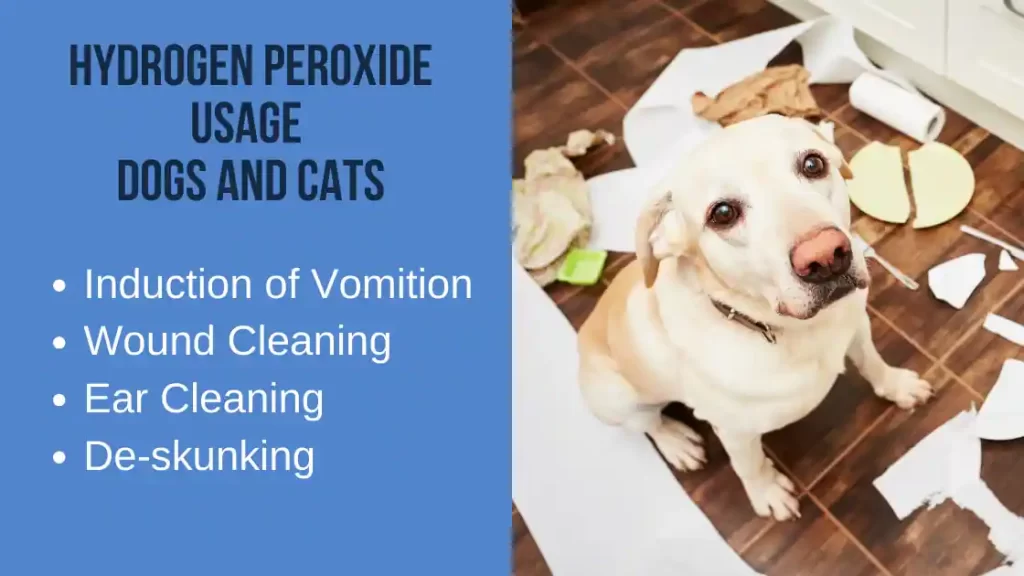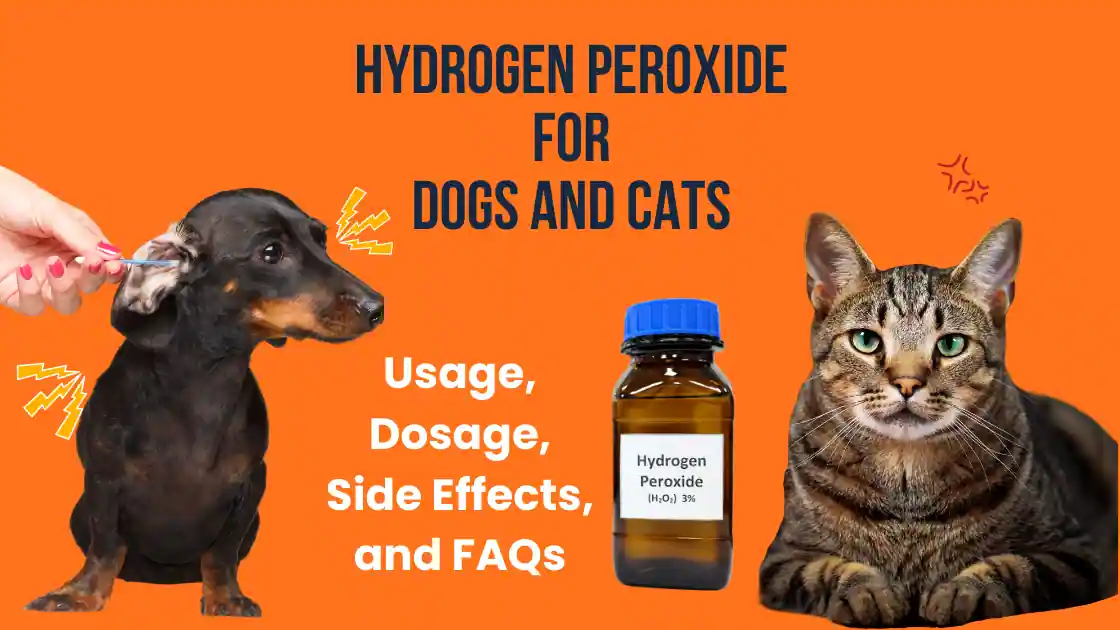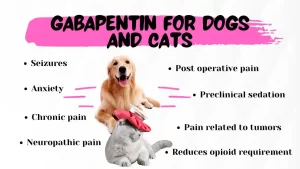Hydrogen Peroxide: Usage, Dosage, Side Effects, and FAQs
I. Introduction:
Hydrogen peroxide is a common household chemical that can be used for various purposes, including first aid treatment for dogs and cats in such as wound cleaning and for disinfection. It is also a well-known remedy for inducing vomiting in dogs and but not in cats. But before administering it to your furry friend, it’s important to understand how to use it properly and the potential side effects.
This article aims to provide a comprehensive guide on using hydrogen peroxide for dogs and cats, including the appropriate dosage, potential side effects, and answers to frequently asked questions. It is important to note that before administering any treatment to your furry friend, consulting a veterinarian is always recommended.
II. What is Hydrogen Peroxide?
Hydrogen peroxide (H2O2) is a chemical compound composed of two hydrogen and two oxygen atoms. It is a colourless transparent liquid that appears as a mild antiseptic and disinfectant. It available as 3% solution for human use and liberates nascent oxygen. Hydrogen peroxide is commonly used to clean wounds, remove stains, removing urine odour and even in certain medical applications.
III. How Hydrogen Peroxide Works?
When ingested orally liberated oxygen irritates oropharynx and gastric lining and induces a vomiting reflex. After application on wounds it oxygenates wound, helps in cleaning the area and eliminates harmful bacteria.
IV. How much time it takes to induces vomiting?
For a dog it takes 10 min to throw up after oral administration. Even a successful induction of emesis or vomiting does not guarantee the complete removal of drugs/ toxins or retrieval of foreign body.
V. Using Hydrogen Peroxide for Dogs:
1. Inducing Vomiting:
- In cases of accidental ingestion of toxic substances (grapes, raisins, rat poison, chocolates, medications or supplement overdose) or non-penetrating foreign bodies, hydrogen peroxide may be used to induce vomiting, eliminating the harmful substance from the dog’s system.
- Hydrogen peroxide should be given withing two hours of ingestion of the toxins like plant leaves, grapes, resins, chocolates etc.
- However, it is crucial to consult a veterinarian or poison control center before inducing vomiting, as some substances can cause more harm when regurgitated.
2. Wound Cleaning:
- Hydrogen peroxide can be used to clean minor wounds on dogs, such as cuts or scrapes.
- Use a clean cloth or cotton ball soaked in a diluted hydrogen peroxide solution (1 part hydrogen peroxide to 10 parts water) to gently clean the affected area.
- Can also be used for cleaning of ears (Diluted).
VI. Dosage of Hydrogen Peroxide for Dogs and Cats:
- Inducing Vomiting:
- The appropriate dosage of hydrogen peroxide for inducing vomiting is typically based on the dog’s weight.
- The general guideline is 1 teaspoon (5 ml) of 3% hydrogen peroxide per 10 pounds (4.5 kg) of body weight.
- The maximum recommended dose is 3 tablespoons (45 ml) for larger dogs. Do not exceed 10 ml in case of use in cats. Cats may show serious side effects of repeated uses.
- Can be repeated only once and given @ 0.25 to 0.5 ml/kg after 15 minutes if first dose fails to induce vomiting.
- It should be given orally with a syringe or turkey baster.
- It’s important to note that it is only recommended to induce vomiting in dogs if instructed to do so by a veterinarian.
- It is crucial to consult a veterinarian for specific dosage instructions, as individual cases may vary and in each case vomiting may not be indicated.
- Feeding of treats or food juts before inducing vomition may produce good result.
2. Wound Cleaning:
- When using hydrogen peroxide to clean wounds, always dilute it before applying to the affected area.
- A safe and effective dilution ratio is 1 part hydrogen peroxide to 10 parts of water.
- It can be used for cleaning of abscess, open contaminated wound and mange or ear (external) mite lesions also.
- It is helpful in flushing surgical drains.
- It has abrasive properties so may delay wound healing.
3. Other uses:
- It can also be used for the cleaning of fur, hairs stained due to blood, stool or urine.
- It can also be used for removal of blood, stool from fabric/ collar etc.
- It can be used for de-skunking your pet.

VII Potential Side Effects of Hydrogen Peroxide:
Hydrogen peroxide can have potential side effects on dogs if given in large quantities or administered incorrectly. Cats are more prone for the side effects. Some common side effects include:
- Irritation to the gastrointestinal tract:
- Hydrogen peroxide can cause irritation to the stomach lining and intestines, leading to discomfort and potential ulcers. In serious complications bloat or gastric dilation and volvulus (GDV) can also happen.
- In case of overdosing with 3% H2O2 in cats necro ulcerative gastritis has been reported as serious side effect.
- Vomiting and Diarrhea:
- In some cases, hydrogen peroxide can cause vomiting and diarrhea in dogs/ cats.
- If the symptoms persist or worsen, seek immediate veterinary attention.
- Damage to the esophagus:
- If higher concentrations (10%) are given orally, hydrogen peroxide can cause severe damage to the esophagus, leading to difficulty swallowing. Sometimes regurgitation in case of poisons like batteries, drain cleaners, strong acids or strong alkali can cause damage to the oeosphagus.
- Metabolic Acidosis:
- Metabolic acidosis can occur due to the uncontrolled release of hydrogen peroxide in the bloodstream, leading to organ failure.
- In rare case oxygen gas embolism may happen as a side effect.
- Aspiration/ Drenching:
- Forceful feeding can result into aspiration of liquid into lungs (aspiration pneumonia) and may be fatal. In case of poisoning of hydrocarbon or petroleum substances like motor oil, kerosene etc may easily get aspirated during induction of emesis.
- It may also cause acute respiratory failure in cats.
- Irritation and Tissue Damage:
- Hydrogen peroxide, especially in concentrated form, can cause skin irritation and tissue damage when applied directly to the skin. Prolonged use also may result in the non-healing tendency of the lesion/ wound.
- Undiluted hydrogen peroxide can damage ear canal and ear drum of the dogs which can result into hearing loss.
- Always dilute hydrogen peroxide before using it on your dog and avoid prolonged exposure.
Treatment of Hydrogen Peroxide Poisoning:
In case of accidental overdosing, or side effects contact your veterinarian immediately. Symptomatic treatment can be instituted using antiemetic, gastric cytoprotectants and probiotics etc in case of gastritis and diarrhoea.
Contraindications:
Not indicated in pets who are already having gastritis or vomiting, lethargic, comatose or having cardiac arrhythmia.
It is not recommended to induce vomiting with hydrogen peroxide in case of ingestion of caustics (acids/ alkali) or sharp objects. Use with caution in brachycephalic breeds and use only in case of recent ingestion of toxic substances.
So before inducing vomiting it is necessary to take complete history and animal should be in good physical condition.
Always remember that cats are more sensitive so never induce vomiting using hydrogen peroxide until your vet recommends it.
In any case it should not be used to clean tear streaks or epiphora even in low concentrations. Accidental contact may result into eyeball damage. Similarly, in case of ear cleaning it may harm the ear canal or internal ear also.

V. Frequently Asked Questions (FAQs):
Q1. Can hydrogen peroxide be used for all types of poisoning in dogs?
Ans: No, not all substances should be treated with hydrogen peroxide. Some toxic substances, such as petroleum-based products or caustic substances, can cause more harm if vomited back up. Consult a veterinarian immediately for guidance.
Q2. Is it safe to use hydrogen peroxide on open wounds? Can you put /use hydrogen peroxide on dogs?
Ans: Hydrogen peroxide can be used to clean wounds in dogs, but it should not be used to disinfect deep wounds as it can damage healthy tissue. It can be used to clean minor wounds, but it is important to dilute it properly. Concentrated hydrogen peroxide can delay wound healing and cause tissue damage.
Q3. Can I use hydrogen peroxide to clean my dog's ears?
Ans: No, hydrogen peroxide should not be used to clean a dog’s ears unless specifically instructed by a veterinarian. Improper use can lead to irritation or damage to the sensitive ear canal.
Q4. Can hydrogen peroxide expire?
Ans: Yes, hydrogen peroxide can lose its effectiveness over time. Always check the expiration date on the bottle and replace it if expired.
Q5. What should I do if my dog ingests hydrogen peroxide?
Ans: Ingesting small amounts of hydrogen peroxide typically does not cause significant harm. However, if your dog ingests a large quantity or experiences adverse symptoms, contact a veterinarian immediately.
Q6. Is it safe to induce vomiting in dogs?
Ans: Inducing vomiting in dogs should only be done under the supervision of a veterinarian if instructed to do so. It should not be done if the dog has ingested a corrosive substance, sharp objects, or if he is unconscious.
Q7. When should I not use hydrogen peroxide for my dog?
Ans: Hydrogen peroxide should not be used if:
– Your dog is unconscious
– The substance ingested is a corrosive substance, such as bleach
– Your dog has ingested sharp objects
– The substance ingested is not toxic or is not harmful in small amounts.
Q8. How long does it take for hydrogen peroxide to induce vomiting in dogs?
Ans: It usually takes around 10-15 minutes for hydrogen peroxide to induce vomiting.
Q9. How to make dog or cat vomit without hydrogen peroxide?
Ans: In veterinary practice Apomorphine (apomorphine is somewhat controversial for cats), or xylazine for dogs and cats are generally preferred emetic agents to be administered. Use of salt or ipecac syrup is not recommended due to profound side effects.
Q10. Dog not throwing up after hydrogen peroxide?
Ans: It happens sometimes and dog do not vomit. After 15 minutes @0.5ml per kg can be given again.
Q11. I gave my dog hydrogen peroxide and he didn't vomit?
Ans: Either repeat the dose as mentioned above or use other agents to induce vomiting. Don’t use any hack without consulting your veterinarian otherwise it may be life threatening.
Q12. Can hydrogen peroxide kill a dog?
Ans: Yes. Excessive vomiting, severe gastritis, cardiac arrhythmia or aspiration may be lethal so should be given under the guidance of a veterinarian.
Q13. Can I give my dog/ cat hydrogen peroxide? Is hydrogen peroxide safe for dogs /cats to induce vomiting?
Ans: Yes. It is indicated for the induction of vomition in dogs and cats both.
Q14. How do I induce vomiting in my dog?
Ans: Vomiting can be induced using many methods like administration of hydrogen peroxide, apomorphine, xylazine etc. Later two must be used by a vet as comes in injectable form.
Q15. How much hydrogen peroxide for dog to vomit safely?
Ans: Recommended dose is 1 teaspoon (5 ml) of 3% hydrogen peroxide per 10 pounds (4.5 kg) of body weight but should not exceed 45 ml in large dogs.
Q16. How to give a dog peroxide?
Ans: It can be given orally with syringe but should not be force fed because may get aspirated in the lungs.
Q17. Hydrogen peroxide dosage chart for dogs?
Ans: Body weight Teaspoon (1TSF=5ml)
10 lbs 1 TSF
20 lbs 2 TSF
30 lbs 3 TSF
40 lbs 4 TSF
50 lbs 5 TSF
For large dogs maximum 3 tablespoons (45 ml)
Q18. Can my dog eat after hydrogen peroxide?
Ans: Yes. After a few minutes you can offer light meal or water. If still vomits then give antiemetic medicine like ondansetron or metoclopramide 30 minutes before offering meal/ water.
Q19. Can you use hydrogen peroxide on cats?
Ans: Yes. It can be used topically for cleaning of wounds, abscess, mange lesions, ears and for inducing vomiting (under vets supervision).
Q20. How to use Hydrogen peroxide and baking soda for cleaning cat urine?
Ans: Put a handful baking soda on the area. Add vinegar to it and leave for 10 minutes. Mix 3% hydrogen peroxide solution in a cup (1/4th) with detergent powder or liquid soap (1 TSF). This combination may cause discolouration of the fabric or floor.
Conclusion:
Hydrogen peroxide can be a useful tool in certain situations involving dogs, such as inducing vomiting in cases of accidental ingestion. The recommended dosage is one teaspoon per 10 pounds of body weight, administered orally. Use with utmost care and caution in case of cats due to possible serious side effects. Always follow proper dosage instructions and be aware of potential side effects. However, it is essential to use hydrogen peroxide cautiously and under the guidance of a veterinarian. There may be potential side effects if given incorrectly, such as irritation to the gastrointestinal tract, esophageal damage, and metabolic acidosis. When in doubt, consult a veterinary professional for advice tailored to your dog’s specific needs.
References:
Obr TD, Fry JK, Lee JA, Hottinger HA. Necroulcerative hemorrhagic gastritis in a cat secondary to the administration of 3% hydrogen peroxide as an emetic agent. J Vet Emerg Crit Care (San Antonio). 2017 Sep;27(5):605-608. doi: 10.1111/vec.12639. Epub 2017 Aug 10. PMID: 28795786.
Niedzwecki AH, Book BP, Lewis KM, Estep JS, Hagan J. Effects of oral 3% hydrogen peroxide used as an emetic on the gastroduodenal mucosa of healthy dogs. J Vet Emerg Crit Care (San Antonio). 2017 Mar;27(2):178-184. doi: 10.1111/vec.12558. Epub 2016 Dec 14. PMID: 27973761.
Rauserova-Lexmaulova L, Agudelo C, Prokesova B. Acute Respiratory Failure after Administration of Hydrogen Peroxide as an Emetic in a Cat. Case Rep Vet Med. 2019 Sep 25;2019:7242631. doi: 10.1155/2019/7242631. PMID: 31662943; PMCID: PMC6791274.





